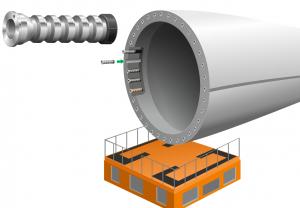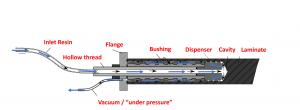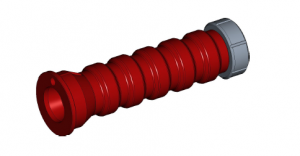
We4Ce patents its Re-FIT wind turbine blade root bushings, meeting demand for on-site repair

Following precision machining and extraction of the damaged bushing, the patented bushing is inserted into the rotor blade root which has been placed in a repair environment within the wind park
60 percent cost-savings; Months of downtime avoided; Lifetime extension; Demand for onsite repair rising; Safety-critical part for bolts to connect to hub
ALMELO, NETHERLANDS, May 28, 2024 /EINPresswire.com/ -- We4Ce, a Dutch supplier of rotor blade bushings, has this month filed an international patent for its “Re-FIT” bushings for on-site repair in the wind park. The new method offers up to 60 percent cost savings and eliminates months of downtime. Older turbines benefit from extended turbine lifetime as repair at the manufacturer or scrapping - the conventional alternatives - are no longer needed. A safety-critical component, blade root bushings, also called inserts, connects the rotor blade with the turbine hub.
“Damage to blade root bushings is enough of a problem to warrant more research. We believe this issue is rising, also in offshore turbines. It affects turbines of all ages, from 1.5 MW to 3 MW and 40-m to 60-m blade lengths. Usually, it occurs after the warranty period,” says Arnold Timmer, managing director of We4Ce.
Glued into the blade during manufacture, defect bushings are complex to remove and insert to precision. A replacement bushing needs not only a strong mechanical connection but also a reliable and uniform bonding to fix the bushing within the blade, the crux of We4Ce’s patent.
With the new repair method, the rotor blade is dismounted on-site and repaired in the wind park. The damaged bushings are extracted and replaced using precision machining. Multiple blade sets can be repaired within weeks.
Previously, the entire blade was shipped to the manufacturer for repair with the associated costly logistics, CO2 emissions and downtime, a significant loss of annual yield.
The patent covers the bonding method and design. An inlet tube placed into the hollow of the bushing is used to infuse epoxy resin into the extremities of the bushing where a proprietary steel resin dispenser has been fixed. The resin is then evenly distributed around the outside of the bushing using vacuum processing, which allows the bonding material to flow uniformly up towards the flange of the bushing. The chosen diameter of the circular dispenser aids the centering and precise placement of the component, previously a challenge.
We4Ce’s repairs offer up to 60 percent savings compared with the cost of a new blade. The solution is suitable for wind parks with more than 10 damaged blade roots. This calculation includes the setup costs and use of a specialized CNC on-site machine drilling out the damaged inserts. Loose bushings are usually detected during inspection of the blade root connection. Cracks in the sealant between pitch bearing and blade root can indicate a loose bushing.
"The Re-FIT method is ideal for turbines with 40-60 percent of lifetime left but can be used for newer turbines. Repair costs at the manufacturer are high, and add to that the additional transport costs and longer downtime of the turbine. Older blade models are not always available, which means the whole wind turbine is sometimes discarded and this is an environmental concern,” adds Timmer.
As the wind industry is calling for a ban on the landfilling of decommissioned blades from 2025, the new repair solution from We4Ce is expected to be a valuable alternative to scrapping.
Loose bushings affect root integrity; the blade can fall off
Bushings are an important structural load-bearing component, which connects the blade to the wind turbine hub via bolts. Each bushing must have sufficient bonding strength capable of withstanding forces of up to 1000kN, the equivalent force of up to 50 passenger cars pulling the blade at the same time.
“If the bushing is not robustly fixed, the load carrying area is reduced. This weakens the connection. Invariably this increases stresses which ultimately reduces blade lifetime,” explains Timmer.
Root causes of damaged bushings
Before accepting a repair job, We4Ce performs a root cause analysis, the company’s core competence.
“Polyester used as interface material to embed the bushing into the blade during manufacture is more susceptible to shrinkage, compared with epoxy resin. If the polyester has not been distributed uniformly around the insert, microcracks can occur and this reduces the bonding surface,” says Timmer.
“Previously, blades were manufactured with higher reserve factors. If this margin for error is reduced for economy reasons, this results in a lower tolerance to variations in loads on-site and in manufacturing,” concludes Timmer.
We4Ce works with Danish CNC Onsite, a company specializing in precision machining of wind turbine components, to offer a combined repair service.
About We4Ce
Headquartered Almelo, the Netherlands, We4Ce has more than 25 years’ experience in rotor blade design, blade root bushing concepts M20-M42, sectional exchangeable rotor blade tips as well as the Re-FIT blade root bushing repair method and root cause analysis. Working closely with wind park owners, We4Ce’s research lab performs a range of fatigue tests and extreme load tests for different sizes and parameter changes, aiding the development of bushings for manufacturers. We4Ce also works with TNO test institute for large size sample testing and approval for the certification bodies, including TüV and UL.
Malene Conlong
Moller International ApS
email us here
EIN Presswire does not exercise editorial control over third-party content provided, uploaded, published, or distributed by users of EIN Presswire. We are a distributor, not a publisher, of 3rd party content. Such content may contain the views, opinions, statements, offers, and other material of the respective users, suppliers, participants, or authors.



